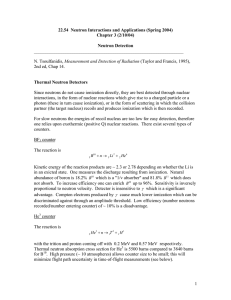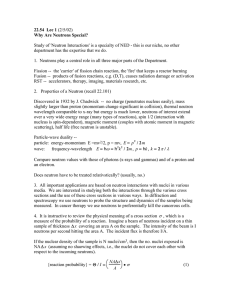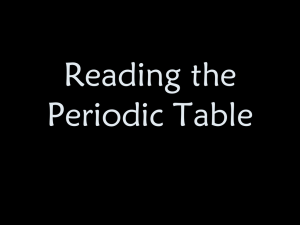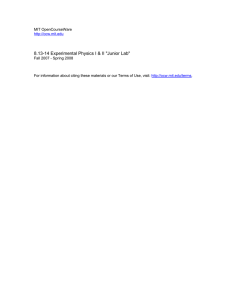__________________________________________________________________ Measurement and Detection of Radiation
advertisement
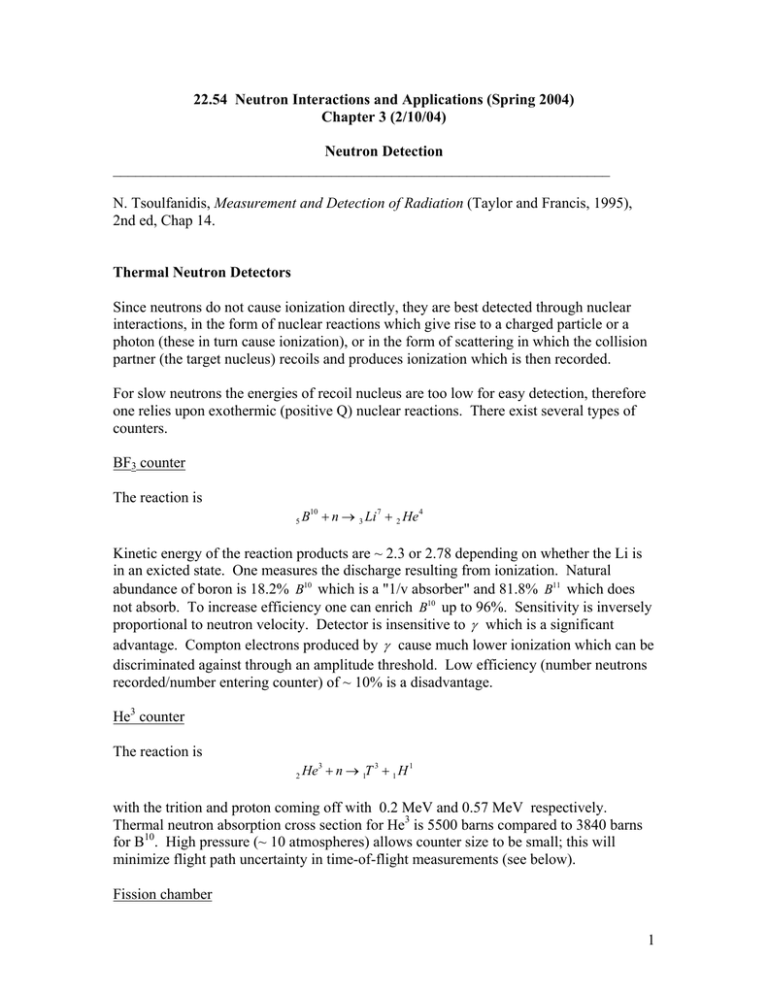
22.54 Neutron Interactions and Applications (Spring 2004) Chapter 3 (2/10/04) Neutron Detection __________________________________________________________________ N. Tsoulfanidis, Measurement and Detection of Radiation (Taylor and Francis, 1995), 2nd ed, Chap 14. Thermal Neutron Detectors Since neutrons do not cause ionization directly, they are best detected through nuclear interactions, in the form of nuclear reactions which give rise to a charged particle or a photon (these in turn cause ionization), or in the form of scattering in which the collision partner (the target nucleus) recoils and produces ionization which is then recorded. For slow neutrons the energies of recoil nucleus are too low for easy detection, therefore one relies upon exothermic (positive Q) nuclear reactions. There exist several types of counters. BF3 counter The reaction is 5 B10 + n → 3 Li 7 + 2 He 4 Kinetic energy of the reaction products are ~ 2.3 or 2.78 depending on whether the Li is in an exicted state. One measures the discharge resulting from ionization. Natural abundance of boron is 18.2% B10 which is a "1/v absorber" and 81.8% B11 which does not absorb. To increase efficiency one can enrich B10 up to 96%. Sensitivity is inversely proportional to neutron velocity. Detector is insensitive to γ which is a significant advantage. Compton electrons produced by γ cause much lower ionization which can be discriminated against through an amplitude threshold. Low efficiency (number neutrons recorded/number entering counter) of ~ 10% is a disadvantage. He3 counter The reaction is 2 He3 + n → 1T 3 + 1 H 1 with the trition and proton coming off with 0.2 MeV and 0.57 MeV respectively. Thermal neutron absorption cross section for He3 is 5500 barns compared to 3840 barns for B10. High pressure (~ 10 atmospheres) allows counter size to be small; this will minimize flight path uncertainty in time-of-flight measurements (see below). Fission chamber 1 Detection makes use of a thin layer of fissionable material ( U 235 , Np 237 , Pu 239 ) to produce ionization by the fission fragments. α background is a problem. Chamber is useful for detection in a small volume. Scintillation counter Light is produced by charged particles emitted in nuclear reactions such as (n,α ) in B10 or Li 6 mixed with ZnS, the scintillation is then observed by a photomultiplier tube. Detection is characterized by high efficiency, high counting rate, and large neutron recording volume. High γ sensitivity can be overcome by pulse shape discrimination. Activation method This has been mainly used for calibration and alignment of instruments. Velocity Selection (Monochromatization) To select a particular neutron energy or velocity in a beam that has a distribution of energies one can make use of either the particle or wave nature of neutrons. Mechanical chopper First slow-neutron chopper was suggested by Fermi. Using a rotor with a slit one can transform a continuous beam of particles into a sequence of pulses as shown in Fig. 1. Fig. 3.1. Using mechanical choppers to produce a sequence of pulses in the neutron timeof-flight method. Slits can be straight or curved. 2 Typically, the flight path A ~ 1 m, so the time-0f-flight is of order 102 µ sec . E[eV ] = 5150 /(tA −1 ) 2 , with t in [ µ sec] , A in [m] Chopper resolution is (∆E / E ) = −2∆t / t = 0.028 E ∆t / A As an example, take E ~ 0.025 eV, ∆t / A ~ 7 µ sec , then ∆E / E ~ 3% The uncertainty in time-of-flight, ∆t , is due to the duration of the original pulse and the analyzer channel width. A single rotor can chop and select neutron velocity at the same time - achieve this with a curved slit (restricted to a fixed narrow energy band). In practice multirotor systems (2, 3 or even 4 successive and synchronized choppers) are usually used. In a 2-rotor arrangement which is most common, the first rotor acts as chopper and the second as selector. This gives a variable neutron energy over a broad range, and reduced fast neutron background. Note: If one has a pulsed source, then chopping is no longer necessary. Advantages of the chopper are wide and weakly collimated beam, simultaneous measurement of many scattering angles, absence of higher-order contamination (relative to the crystal monochromator), and easy variation of velocity selection. A disadvantageis that the beam is used only during a small fraction (~ 10-2) of the time - low duty cycle. Crystal monochromator This method is based on the Bragg condition for reflection, nλ = 2d sin θ B where n is the order of reflection, λ the neutron wavelength, θ B the angle of incidence (or reflection), and d is the spacing between lattice planes. The energy resolution is ∆E / E = 2∆λ / λ = 2cot θ B ∆θ B Typically ∆θ ~ 20', so ∆λ / λ ~ 1%. More precisely, ∆E / E = 2cot θ B ∆θ B + 2∆d / d where ∆d / d is the mosaic spread, a measure of the imperfection of the crystal lattice planes. The first term in the energy resolution is of order 10-2 while the second term if of order 10-4-10-5. 3 Notice that going to higher energy (smaller λ , therefore smaller θ ) means the resolution gets worse. One can obtain exceptionally good resolution bv going to backscattering ( θ B ~ π / 2 ), then the resolution is determined by the mosaic spread. This is the principle for the so-called backscattering spectrometer. In practice one uses the first-order reflection, n=1, and tries to suppress the higher-order reflections. This does not apply to cold neutrons where the second order is actually closer to the peak of the Maxwellian. One can remove higher-order neutrons by using a mechanical chopper or a filter (see below). Also there are single crystals which do not produce second-order reflections because of symmetry (e.g., Ge, magnetite). One can use bent crystals to focus a beam and thereby increasing its intensity. Filters This makes use of the sharp Bragg cutoff cross section in polycrystalline Be or C. See Fig. 2. Useful filter materials and their cutoff energies and wavelengths are shown in the Fig. 3.2. Using a polycrystalline filter to select a portion of the spectrum of an incident beam (typically a Maxwellian). Cooling the filter makes the drop in cross section sharper and thus achieving a more effective filtering. Table 3.1. Bragg cutoff energy and corresponding wavelength for various neutron filter materials. Material _______ Be BeO Pb C Bi Eo [eV] ______ 5.2x10-3 3.7 2.5 1.83 1.28 λo [A] _____ 3.95 4.68 5.7 6.69 8 4 In the method of "difference filters" one makes measurements using 2 different filters, the result is then due to neutrons in the overlap region. A related method is the "window filter". Single-crystal filters like quartz can be used to reduce other radiations. For example, 27.5 cm of quartz, cooled to nitrogen temperature, has attenuation factors of 25 (fast neutrons), 2000 (resonance neutrons), 2.5 (thermal neutrons), and 30 (2 MeV γ ). One can use bent tubes as a "pipe" (mirror reflection) for cold neutrons, E ≤ 10-3 eV, and in this way bring the neutrons out of the reactor bay area where space is limited for sample holders and instruments such as choppers and monochromators. Hence the name "guide tubes". 5

